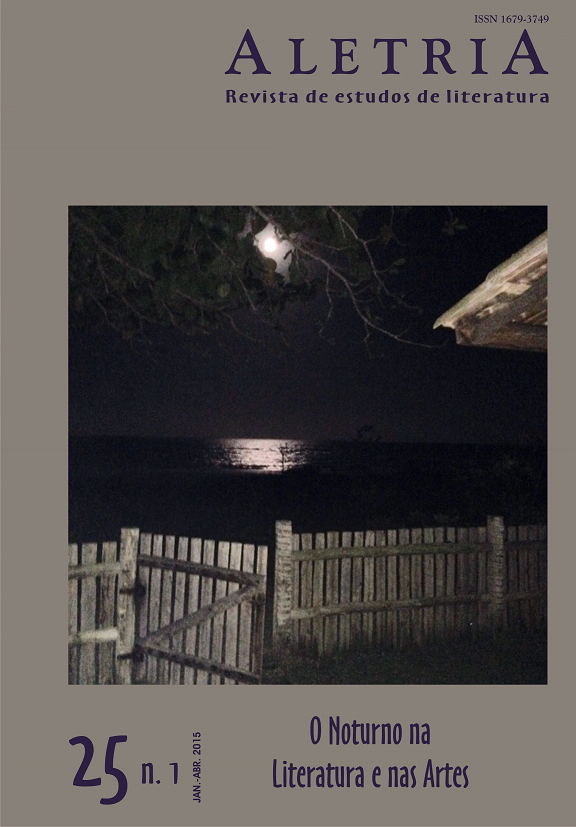Surrealism Experimentations and Approaches of the “Night”: Analyzes of the Metaphorical Discourse in Paul Éluard and Murilo Mendes
DOI:
https://doi.org/10.17851/2317-2096.25.1.51-67Keywords:
Éluard, Murilo Mendes, metaphor, mimesis, nightAbstract
Many are the examples of the way the metaphors of the night enrich the poetry as representation of the world. Especially in the Surrealistic Poetry, the construction of a lateral system of references, directly connected to a wider and discursive organization contributed to the foundation of other way to represent and to present the universe related to the sign of the night. This paper aims to analyze some examples in the poetry of Paul Éluard, one of the most important poet in the French literature, and Murilo Mendes, Brazilian poet linked to the Modernist movement and attached to a number of surrealistic mechanisms in order to express a Brazilian lecture of the innovations the Parisian movement brings. An especial attention made to the structure and the functions assumed by the words related to the mimetic domain of the night, reveals how some surrealistic procedures and linguistic experimentations are capable to created alternatives to a model of representation based on conveniences and a logic codification of the literature language.
Downloads
References
ARISTÓTELES. La Poétique. Dir. Roselyne Dupont-Roc, Jean Lallot. Paris: Seuil, 1980.
ARISTÓTELES. Manifeste surréaliste. In: ARISTÓTELES. Œuvres Complètes, v. I. Paris: Seuil. 1993.
BRETON, André. Qu’est-ce que le surréalisme. In: BRETON, André. Œuvres Complètes, v. I e II, Paris: Gallimard, 1993.
ÉLUARD, Paul. Capitale de la douleur. In: ÉLUARD, Paul. Œuvres Complètes. v. I. Paris: Seuil, 1968.
ÉLUARD, Paul. Répétitions. In: ÉLUARD, Paul. Œuvres Complètes. v. I. Paris: Seuil, 1968.
ÉLUARD, Paul. Mourir de ne pas mourir. In: ÉLUARD, Paul. Œuvres Complètes. v. I. Paris: Seuil, 1968.
ÉLUARD, Paul. Chanson complète. In: ÉLUARD, Paul. Œuvres Complètes. v. I. Paris: Seuil, 1968.
FRYE, Northrop. Anatomy of Criticism. Princeton: Princeton University Press, 2000.
GREIMAS, A. J. Sémantique structurale: recherche de méthode. Paris: Presses Universitaires de France, 1986.
JAKOBSON, Roman. Linguistique et poétique. Essais de linguistique générale. 1. Les fondations du langage. Trad. fr. Nicolas Ruwet. Paris: Les éditions de Minuit, 1963.
JAKOBSON, Roman. Questions de poétique. Paris: Seuil, 1973.
MENDES, Murilo. Poesia Liberdade. Poesia Completa e Prosa. Rio de Janeiro: Nova Aguilar, 1994.
MENDES, Murilo. Metamorfoses. Poesia Completa e Prosa. Rio de Janeiro: Nova Aguilar, 1994.
MENDES, Murilo Os Quatro Elementos. Poesia Completa e Prosa. Rio de Janeiro: Nova Aguilar, 1994.
MESCHONNIC, Henri. Critique du rythme: anthropologie historique du langage. Paris: Verdier, 2009.
RICHARDS, I. A. The Philosophy of Rhetoric. New York : Oxford University Press, 1965.
RICŒUR, Paul. La métaphore vive. Paris: Seuil, 1975.
Downloads
Additional Files
Published
How to Cite
Issue
Section
License
Copyright (c) 2015 Carolina Cunha Carnier (Autor)

This work is licensed under a Creative Commons Attribution 4.0 International License.
Authors who publish with this journal agree to the following terms:Authors retain copyright and grant the journal right of first publication with the work simultaneously licensed under a Creative Commons Attribution Non-Commercial No Derivatives License that allows others to share the work with an acknowledgement of the work's authorship and initial publication in this journal.Authors are able to enter into separate, additional contractual arrangements for the non-exclusive distribution of the journal's published version of the work (e.g., post it to an institutional repository or publish it in a book), with an acknowledgement of its initial publication in this journal.Authors are permitted and encouraged to post their work online (e.g., in institutional repositories or on their website) prior to and during the submission process, as it can lead to productive exchanges, as well as earlier and greater citation of published work (See The Effect of Open Access).





